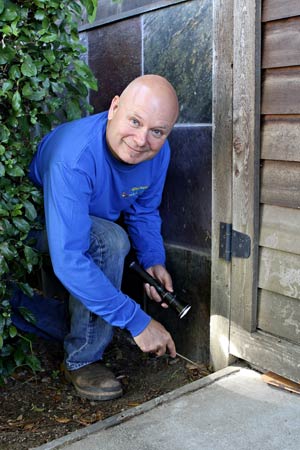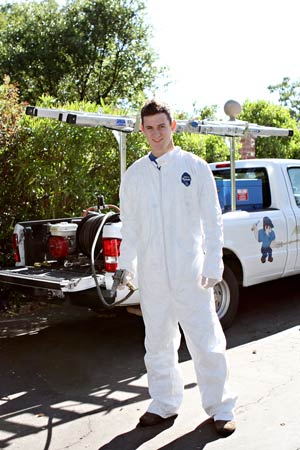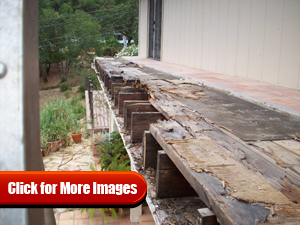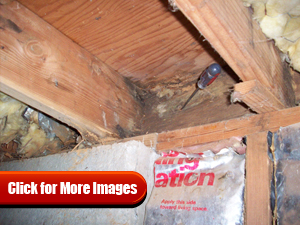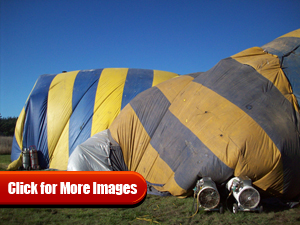

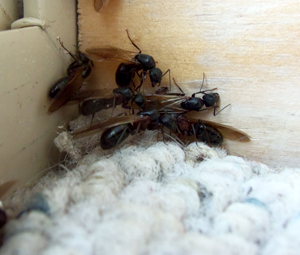 CARPENTER ANTS
CARPENTER ANTS
One of the more exciting insects we deal with here in northern California is the carpenter ant. Why? Because they are generally very big, they can be aggressive and during swarming seasons they invade interiors of homes in large numbers. Carpenter ants are most prevalent on the coast and in wooded areas such as hills around Ukiah or Willits. Carpenter ants do not eat the wood for food however they chew out the wood to create galleries and nesting sites. They generally find a spot in the house with elevated moisture content and are often in areas where fungus damage has or is occurring. The key visual difference between termites and ants is that you can see several segments in the ants body and you can with a termite. With the introduction of Termidor sc we no longer have to spray chemicals on the interior of your house to eliminate your carpenter any problems. Two treatments on the exterior of the structure will eradicate your ants in about 30 days and Mendo Lake Termite gives a full one year warranty with this type of treatment. In the “old days” treating for carpenter ants meant monthly service calls and success was measured on how few ants were seen between treatments. Now we can eliminate the queen and the entire nest using Termidor due to the transference effect as the ants bring Termidor back to the nest and quickly eliminates the nest without the need to spray chemicals inside your home.
FUNGUS AND WATER DAMAGE
Most people call damage caused by fungus “dry rot” however this is really a misnomer and it should be called wet rot as the cause for this damage is excessive moisture. More damage is caused by fungus here in northern California than by termites and wood boring beetles. Almost all wood homes have some damage caused by wood decay fungus due to our mostly older, rural to forested home sites. We also have a substantial rainfall amount and often our homes are wet to flooded in the crawlspaces during the winter months. If your home gets damp or wet and lacks proper ventilation, fungus decay is likely. Visible signs of wood decay fungus starts with a white, spongy growth on the outside of the wood. If the fungus continues to grow unabated, the woods strength is damaged by the destruction of the wood cells as the fungus feeds on the starch and sugars in wood causing the cells to collapse and weaken. Fungus must be attacked by 1st reducing the moisture content in the affected area, replacing all damaged framing members, treating the area surrounding the repair with a fungicide such as borate based Timbor. Regular inspections to monitor and control excessive moisture conditions and treatment of fungus while it is still on the surface are important to reduce costs of repair. Fungus damage can occur much faster than termite damage occurs. Please don’t underestimate the seriousness of fungus decay. People often get very upset if they find termites, while shrug off fungus damage. Wood framing has to be replaced in both instances however fungus decay happens in weeks to months where extensive termite damage takes several years to occur.
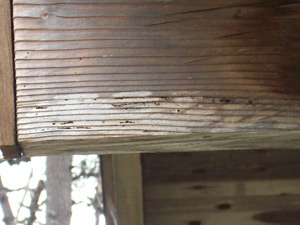
DAMPWOOD TERMITES
Dampwood termites can be found anywhere in Lake, Mendocino, and Sonoma counties where the conditions are right. Dampwood termites can only infest in wood with extremely high moisture content and are often found in framing which is already damaged by fungus. Common areas of infestation are decks, areas in structures that stay wet due to plumbing or roofing leaks. Dampwood termites can be identified by their size and color. They are the largest termite; about ¾ of an inch and the color of the winged swarmers is reddish brown as opposed to black for Subterranean and Drywood termite swarmers. The correct method of eradication for Dampwood termites is to remove and replace all the infested and damaged wood, stopping or correcting the excessive moisture condition. A topical treatment of borate based Timbor is also suggested.
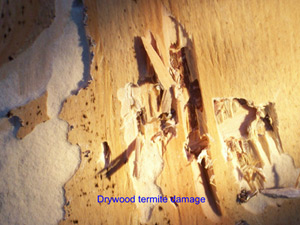
DRYWOOD TERMITES
Drywood termites are the most common termite on the Mendocino and Sonoma coasts. They are also found in Ukiah along the eastern and western hills and have been found in homes all around Clear Lake in Lake County. This type of termite is distinguished by its fecal material or droppings which are like small granules of wood, shaped like small footballs. The droppings are the same color as the wood in which the termites are feeding. Drywood termites can be distinguished from subterranean termites by their size. Drywood termites are much larger, about twice the size of Subterraneans and of course the most obvious is the fecal material. Drywood termites create fecal pellets and Subterraneans do not. Drywood termite eradication is generally more difficult than treating for Subterranean termites as Drywood termites create their nest in the house structure generally in a most difficult area to reach. Often when Drywood termites have been active for several years, they create several or multiple individual nests in the same structure. Locating all of the nests can be challenging. That is why the Structural pest control board suggests tenting or fumigation as the "most assured method" of eradication. If the infestation is new and accessible spot treatment methods are available and can be successful if the treating applicator is knowledgeable. We often suggest fumigations if the house is being sold as this method is proven and effective. Spot treatment injections should be followed up with inspections to monitor the success or failure of the treatment so that the homeowner and Mendo Lake Termite can take additional action if needed.
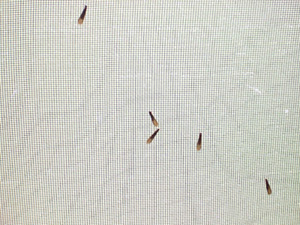
SUBTERRANIAN TERMITES
Subterranean termites are the most common and by sheer numbers, the most destructive wood destroying insect in Lake, Mendocino, and Sonoma counties. Many homeowners misdiagnose these insects as "flying ants' and therefore let the infestation continue to eat and cause damage to their homes. Please look at the pictures and remember the three visible differences between termites and ants. 1.There are three visible different segments in an ant body. You can only see the head and abdomen of a termite. 2.Termites have equal length wings, ants have unequal length wings 3.Termites have straight antenna, ants antenna are elbowed. Generally speaking the inland and wooded areas are where subterranean termites are most likely to infest. We have found that right along the coast, they are far less likely to infest and are generally not a threat. Subterranean termites are generally encouraged by the bad practice of builders leaving scrap wood debris or form lumber under houses. This food on the ground is often the source for initial infestations to occur. Homeowner often increase their odds of infestation by poor landscaping practices of raising soil levels around homes, creating close or even earth to wood contacts and termites gain entry. Subterranean termites typically do not start and gain entry into your home unless aflaw or encouragement is present. If we find subterranean termites in your home, we will recommend completing a treatment using registered product Termidor. This is the #1 termiticide in the U.S. and throughout the world. It has a "Caution" label which is the least toxic level or tier. In fact Termidor is successful because it doesn't kill the termites at all for several weeks. The termites cannot even detect it. Therefore they continue to work and pass through the treated areas. They bring the chemical back to the nest and spread it to the Queen, breeding males, soldiers, and the workers. We treat around the outside and under your home. Mendo lake termite gives a three year warranty with our treatments. This is one or two years longer than most of our competition. We do the job right and therefore we can offer this longer warranty without worry.
BEETLES
There are three main types of wood boring beetles which attack homes in northern California. Powder post beetles. They are broken into two subsets. True powder post beetles attack hardwoods and are generally found in antique furniture or hardwood flooring. False powder post beetles are more common in our area as they commonly attack Douglas fir framing in subareas of homes. The frass or fecal material of these beetles is like fine powder, hence the name—powder post. The third common beetle in our area is called the “death watch” beetle as it is often active well into the evening and can be heard if the infestation is near your bedroom. In medieval times, people who were watching over sick or dying family member often heard the sounds of these beetles. The sound was thought to be the staff of the grim reapers scythe. Wood boring beetles often work for years without being detected as they do not have a swarming time like termites or ants. They often work for years in subarea framing and are not detected until damage has occurred. Wood boring beetles are most common in homes located in forested settings and also in homes where the owners regularly store and burn firewood. Eradication of wood boring beetles is somewhat difficult. If the infestation is substantial and is thought to extend into inaccessible areas- fumigation or tenting is the best choice. If the infestation has been detected while it is limited to accessible areas, a treatment of Timbor, a borate based solution is effective and costs substantially less. Reducing the moisture content in your subarea is also vital for long term control. Remember most wood boring insects including beetles desire wood with elevated moisture content.
TREATMENT & TENTING
Fumigation is the process of treating the whole house for wood destroying beetles, termites and sometimes even carpenter ants. Fumigation is a very big job and typically is used when the infestation is very extensive. We complete far more fumigations on the coast where the weather is wetter, cooler and there are more trees.
The main fumigant on the market is called Vikane and the active ingredient is Sulfuryl fluoride.
Prior to the fumigation date you are given a set of papers called the “occupants fumigation notice”. In these papers are information regarding preparing your house and safety . I would also encourage you to read about fumigations and visit web sites both on the commercial side, and on the intellectual side such as those you will find at UC Berkeley or UC Riverside. If you are like me, you will read everything you can before making your decision.
When the crew shows up, the house is surveyed to make sure all the plants have been cut back away from the house, that no other attachment or obstruction to install the tent is present. Now the fun begins as young strong men haul large heavy tarps up on top of the roof and start rolling and clipping the seams of the special tarps creating a large tent. The lower edges are held down with sand snakes. The lead fumigator releases the proper dosage to the interior. The amount of gas is based on the cubic size of the job. Cost is also based on size of job and location. In conclusion we look at the job and ask ourselves what is the most cost effective way of eliminating the problem infestation. Sometimes simply changing out the infested wood, sometimes a local spot treatment, and sometimes fumigation is the best choice.

